ABSTRACT
Updated result of the phenotypic characterization and description of the indigenous sheep population was reviewed. The reviewed paper used reporting and tabulating published descriptive phenotypic information on Ethiopian breeds with the aim of dissemination of relevant information for the beneficiaries. The original sheep breed types in Ethiopia that migrated from South West Asia to Africa and then to Ethiopia were the thin-tailed, fat-tailed and fat-rump. Through time, they evolved into 14 traditionally recognized sheep breeds which are identified and described through phenotypic characterization of the representative sample flocks. The breeds adapted to different agro ecological zones varied in topographical features and humidity. The overall reviews of the adult average live body weight variation of the local sheep population of Ethiopia are classified into 20 to 25 kg (Elle, Abergelle and Menz); 26 to 30 kg (Afar, Tikur, Highland sheep, Washera and Black Head Somali [BHS]); 31 to 35 kg (Bonga, Begait, Horro, Arusi-Bale and Farta) and 36 to 40 kg (Gumuz). The large sheep breeds of Ethiopia are Begait, Washera, Gumuz, Horro and Bonga. There is a variation on phenotypic performance among the sheep breeds of the Ethiopia in terms of body shape and size, ear profile and size, head profile, tail size and shape, coat color and on the adaptive behaviors. Molecular characterization should be done for comprehensive genetic evaluation and classification of the indigenous sheep population at national level.
Key words: Sheep breed, phenotypic variation, sheep classification, tail type and tail shape.
The ancient process of domestication of wild mammalian species contributes for the emerging of diversified domestic animal species. More emphasis is given to the adaptability of the wild animals towards the interventions of the ancient human beings controlling them so that they can obtain valuable food products from the preferable the wild animals. Sheep (Ovis aries) is considered the first domesticated livestock species during 11000 to 9000 BC in Southwest Asia from its wild ancestry of Ovis orientalis (Oldenbroek and Van der, 2014). It is greatly emphasized that South West Asia served as a route for distribution of domesticated sheep to different directions all over the world especially to Africa along with migrant peoples (Solomon, 2008). The introduced domesticated sheep develop an adaptation mechanism to different agro climatic conditions and own unique characteristics since thousand years ago. Ethiopia with its varied topographical features and diverse agro ecological Zone is believed as a home for many sheep breeds (Birara, 2016). The estimated total sheep populations of Ethiopia accounts for 30.7 million from which 27.86% of the total are male while 72.14% are female (CSA, 2017). Flock composition of the sheep breeds of Ethiopia is estimated as 26.2, 10.8, 10.9 and 52.0% for the age categorization of <6 months, 6 month to 1 year, 1 year to 2 years and 2 years and older, respectively (CSA, 2017). However, the local sheep breeds are generally characterized with low level of productivity in terms of growth rate and carcass yield (Mengesha and Tsega, 2012). Various research reports indicated as there are efforts to improve the productivity of the local sheep through improving management and husbandry interventions, implementing breed improvement through selection and crossbreeding for terminal cross breed. Nowadays with existing awareness on impact of climate change, due emphasize on production improvement is advised to take advantage of the locally adapted breeds. In favor of this recommendation, there are many research works on the phenotypic characterization of sheep breeds along with the description of their production system in different regions of Ethiopia. However, making the separately conducted characterizations of locally adapted sheep breeds as comprehensive review is the main gab at national level concerning delivering updated information on breed characterization, inventory and monitoring of sheep genetic resource management. Therefore, information dissemination by reviewing such research findings to interested readers and beneficiaries is important for developing breed improvement strategies both at regional and national level to take advantage of the locally adapted sheep breeds through implementing selection within and between the breed populations. Concerning the backgrounds, the objective of this paper was to deliver updated information by reviewing the findings of phenotypic characterization of sheep breeds to beneficiaries.
HISTORY OF SHEEP DOMESTICATION
What changes after domestication of a wild mammalian species? The first process begins after the wild animal assumed themselves as they are under controlled environment is changing in their behavior. The changing in the behavior of the domesticated animal is directly related to the word “Tame” and it is considered as the continuous process (Oldenbroek and Van der, 2014). The process of domestication is also related to the biological context in which the domesticated sheep are benefited from having successful reproductive while humans can get the valuable products from them. Such kind of biological relationship between sheep and human is called mutualism which is directly related to the word co-evolutionary process, the most appropriate perspective of domestication (Gifford and Hanotte, 2011). The introduction of domesticated sheep (Ovis aries) to Africa from their origin of domestication (South Western Asia) is reviewed as it happened within few time ranges of their domestication through North Africa “Sinai” found in Egypt society during eight and seven thousand years ago (Blench and Donald, 1999). The present sheep type of Africa are classified into two groups based on the tail types, thin tailed and fat tailed or fat rumped (Gifford and Hanotte, 2011). Due to the wide range of adaptability of the introduced sheep, the existing sheep types in different part of Africa not only differed in tail type but also differ in coat color, horn shape, face profile and body conformation.
BIODIVERSITY OF SHEEP POPULATIONS AND THEIR CLASSIFICATION IN ETHIOPIA
There are different sheep breeds found in different Agro ecological Zones of the country. The factors that shaped the existing types of sheep are the process of domestication, natural selection and human intervention over thousand years ago (Hanotte and Jianlin, 2005). According to the African sheep classification method, these sheep breeds of Ethiopia are classified into two major sheep family groups of “thin tailed” and “fat tailed” (Gifford and Hanotte, 2011). Many of the reviewed papers concerned are discussed in reference to the research report work done of Solomon (2008), who has done research on sheep genetic resource analysis in Ethiopia and the current paper is also reviewed in reference to the outcome of research report of the aforementioned resource scholar. Accordingly, the early introduced major sheep families mentioned above are distributed into different part of Ethiopia and are still evolved since a long period of time to cope with the existing and dynamic environmental conditions resulting sub family within each of the two major families (Solomon, 2008). Up to 18 local sheep population types are found in the natural landscape of Ethiopia kept by different tribes in different parts of the country (Tibbo, 2006).
Classification of the local sheep based on tail type in this paper is based on the qualitative aspect of length and shape of the tail. There is a paper that reviewed the tail type classification of local sheep in Ethiopia into short-tailed, long tailed, fat-rump and thin-tailed types (Mengesha and Tsega, 2012). The current paper is reviewed on the updated research work done on currently addressed phenotypic characterization of various local sheep breeds of Ethiopia including Begait sheep with the longest thin tailed up to 50 cm long (Amare et al., 2012).
ADAPTATION BEHAVIOR TO VARIOUS AGRO ECOLOGIES ZONES IN ETHIOPIA
The various sheep breeds along with their adaptation information are listed in Table 1 based on the published report and the information is collected from different published sources. Some authors suggested that the habitation of local sheep in Ethiopia is restricted to the ecological requirements (Solomon, 2008).
This suggestion is supported in relation to the tail type and its variation between locally adapted sheep. The variation of tail type and shape in relation to the ability of the local sheep to adapt to the change in feed availability. It might be true if the local sheep are fat tailed in feed shortage area with developed mechanism for energy reserving and thin tailed in area with excess feed available (Solomon et al., 2011; Kassahun and Solomon, 2009). Similarly, there is a variation on the adaptability of the local sheep population of Ethiopia across the varied agro ecological conditions.
DESCRIPTION OF THE PRODUCTION SYSTEM OF INDIGENOUS SHEEP BREED OF ETHIOPIA
Almost all of the local sheep are reared kept under mixed crop-livestock, specialized pastoral and agro pastoral of the three major livestock production system in Ethiopia (Solomon et al., 2010a;b). In some areas of the western and north western zone under the regional government of Tigray, there are commercial farmers who produced Begait sheep flock for specialized mutton production (Gebregiorgis et al., 2016). Sheep flock management is mainly based on the extensive feeding system in which herded sheep flocks are freed for grazing during the day time and kept indoors during the night. It is widely known that Afar and BHS sheep population are mainly kept under the pastoral and agro pastoral production system (Gemeda, 2010; Wendimu et al., 2016). The overall reviewed information on the production system of the local sheep in Ethiopia as they are kept mainly (75%) under small scale crop-livestock mixed farming system of highland agro ecology (Tibbo, 2006).
BREEDING OBJECTIVE OF THE LOCAL SHEEP OF ETHIOPIA
There are evidences about the breeding objectives of sheep in Ethiopia that indicate majority (52.01%) of the adult sheep with the age of 2 years and above are kept for breeding (48%), mutton (2.6%) and wool (≤1%) managed under subsistent production system which is reported by CSA (2017). However, the productivity of the local sheep is still below the requirement for international competitive market standards of mutton. The slaughter weight and carcass yield of the yearly male sheep under feedlot is very low. Recent research outputs indicated that the average slaughter weight and hot carcass yield for yearly male highland sheep found in Tigray under feedlot varied between 17.0 to 20.0 kg and 6.8 to 9.1 kg, respectively with the range of 39.7 to 45.2% dressing percentage based on the average slaughter weight (Urge et al., 2016). Other research output for Begait yearly male sheep indicated that the average slaughter weight and hot carcass yield varied within the range of 32.5 to 30.3 kg and 14.0 to 15.3 kg, respectively with the range of 46.5 to 49.7% dressing percentage based on the average slaughter weight (Michaele et al., 2017). The aforementioned two referenced information on the carcass yield performance are based on the feedlot basis. The overall range on mutton production performance for Ethiopian local sheep is reported as 10 to 12 kg (Berhe, 2010). This information indicates a variation on the phenotypic performance of the local sheep of Ethiopia which can be an input for designing valuable breed improvement strategies.
PRODUCTION PERFORMANCE OF THE INDIGENOUS SHEEP BREED OF ETHIOPIA
Information on production and reproduction performance are collected from different published resources and summarized in Tables 2 and 3. The current paper reviewed the variation on production and reproduction performance of the local sheep shown subsequently with respect to the type of sheep flock management under smallholder farmers. To avoid biased flock productivity evaluation, the paper collected published research reports conducted under smallholder farmers so that the performance evaluation is under the traditional flock management condition.
Growth performance of the local sheep of Ethiopia
The paper presented related information on the growth performance of 14 traditionally recognized sheep population listed in Table 2 with respect to the age categories. The information is collected from different published research work done on farm phenotypic characterization conducted in different seasons and varied agro ecological and environmental conditions. Estimation of age using teeth dentition is developed for Ethiopian sheep as 0 PPI, 1 PPI, 2 PPI, 3 PPI and 4 PPI which are equivalent with the age categories of ≤ 1 year, 1-1½ years, 1½-2 years, 2½-3 years and more than 3 years (Solomon and Kassahun, 2009). The minimum average live body weight at yearly age (1 PPI teeth dentition) was attained with 18.9 and 17.4 kg for male and female, respectively in Abergelle sheep (Seare et al., 2011) while the maximum average live body weight in the same age category was attained with 29.4 and 25 kg for male and female, respectively in Arsi-Bale sheep (Hizkel et al., 2017).
Using the information obtained from different resources listed in Table 2, the paper reviewed that the average growth rate (kg) for Ethiopia male sheep breeds was 19.2, 24.8, 28.2, 30.8 and 31.4 in the age categories of 0 PPI, 1 PPI, 2 PPI, 3 PPI and 4 PPI, respectively while in the female sheep breeds the average growth rate (kg) was 16.9, 22.7, 25.2, 27.5 and 29.9 in the respective age categories. Using the information listed in Table 2 collected for 14 sheep breed breeds from different sources, the average live body weight (kg) at adult age (2 PPI to 4 PPI) ranges from 22.8 to 34.9 for Abergelle (Seare et al., 2011) and Begait (Amare et al., 2012) sheep breeds, respectively. Based on the aforementioned information, there is a variation among the sheep breeds of Ethiopia on the phenotypic performance which is a potential for designing appropriate breeding strategies to improve production levels of the locally adapted sheep. It is many times reviewed that sheep breeds of Ethiopia are generally characterized as slow growth, late maturity and low production performances (Mengesha and Tsega, 2012). The current paper agreed with the general suggestion on the low productivity level of the locally adapted sheep breed of Ethiopia as compared to other breed like Dorper sheep rams and ewes weighing 100 to 120 kg and 60 to 80 kg, respectively (Gavojdian et al., 2013). However, the main cause for low productivity of the locally adapted sheep in Ethiopia might be due to the lack of appropriate breeding strategies. Some scholar indicates as there are large sized sheep breeds in Ethiopia like Begait sheep weighting 45 to 60 kg and 45 to 50 kg for adult male and female, respectively (Gebregiorgis et al., 2016).
REPRODUCTIVE CHARACTERISTICS AND VARIATION ON INDIGENOUS SHEEP OF ETHIOPIA
The indigenous sheep of Ethiopia have developed important reproductive traits from twining to the possibility of multiple births (Begait up to 6 offspring per birth). Due to poor flocks management of the smallholder farmers, only two of the offspring are able to grow and survive. Indicative information regarding to the reproductive traits for some of the indigenous sheep are listed in Table 3 collected from different published resources.
Average age at puberty
Male sheep have an average age at sexual maturity of 6.3 and 10.7 months for Black Head Somali [BHS] (Helen et al., 2015) and Menz sheep (Gizaw et al., 2013), respectively, whereas the female sheep have an average age at sexual maturity of 6.3 and 9.7 months for Washera (Michael, 2013) and for Begait sheep (Assen and Aklilu, 2012), respectively (Table 3). The aforementioned information is reviewed to show the range of variation on the average age at puberty of the indigenous male and female sheep of Ethiopia under extensive flock management conditions.
Average age at first lambing
According to the information collected, the average age at first lambing for Ethiopian sheep breeds ranges from 12.1 to 14.9 months for Highland sheep (Weldeyesus et al., 2016) and for Bonga sheep (Zewdu, 2008), respectively. The range of average age at first lambing for indigenous sheep breeds of Ethiopia is in line with the findings of Tsedeke (2007) for Alaba sheep. The current paper reviewed that the variation on the age at first lambing may be due to agro ecological effect, breed type and season at which they are born. Some authors suggested that the variation due to the age at puberty and age at first lambing is as a result of the agro ecological effect; indicated as sheep adapted in highland reaches at puberty age earlier than sheep adapted in lowland (Assen and Aklilu, 2012).
Lambing interval and weaning age
Based on the collected information on lambing interval for Ethiopian sheep breeds listed in Table 3, there is a possibility of attaining this expectation. A potentiality of having two successive lambing per year in some of the indigenous sheep is reported for Bonga, Abergelle, Highland sheep, BHS (under mixed crop livestock production system) and Gumuz with the average lambing interval of 7.8 months (Zewdu, 2008), 6 months (Seare et al., 2011), 6.5 months (Weldeyesus et al., 2016), 6.6 months (Helen et al., 2015) and 6.4 months (Solomon et al., 2010a; b), respectively. The other possibility is having two successive lambing within the consecutive period of two years with somewhat extended lambing interval of 8.5 months to 10.2 months for Menz (Gizaw et al., 2013) and BHS under pastoral (Helen et al., 2015), respectively. The average weaning age for indigenous sheep breeds of Ethiopia varies in between 3 months for Washara sheep (Mengistie et al., 2010) to 5.1 for Tikur sheep (Tassew et al., 2014).
Litter size and mortality rate
The average litter size for indigenous sheep breeds of Ethiopia varies within the range of 1.0 for BHS reared under agro-pastoral (Helen et al., 2015) and 1.6 for Horro (Zewdu, 2008). The indicative information on mortality rate for Ethiopian sheep varies in between the range of 11.9% for Arusi-Bale (Hizkel et al., 2017) to 26% for Bonga sheep (Zewdu, 2008).
PHENOTYPIC IDENTIFICATION AND CLASSIFICATION OF THE INDIGENOUS SHEEP
The current reviewed paper collected information about 14 indigenous sheep population of Ethiopia so far identified and their major descriptor features are listed in Table 4. The indigenous sheep breed of Ethiopia are identified as Begait (Figure 1), Gumuz (Figure 2), Farta (Figure 3), Abergelle (Figure 4), Highland sheep (Figure 5), Elle (Figure 6), Arsi-Bale (Figure 7), Horro (Figure 8), Bonga (Figure 9), Menz (Figure 10), Afar (Figure 11), Tikur sheep (Figure 12), BHS (Figure 13) and Washera (Figure 14).
Tail type and shape description
The dominant observed descriptors from the result of phenotypic characterization of the sampled sheep flock which are listed in Table 4 are collected from different sources. Based on the sourced information collected, the local sheep developed a variation on tail type and shape. Classification of the local sheep population based on the tail type and shape is reviewed by Mengesha and Tsega (2012), Solomon (2009) and Tibbo (2006). However, the previous reviewed papers were not updated to incorporate the newly identified sheep breeds by MSc student research work (Figure 15).
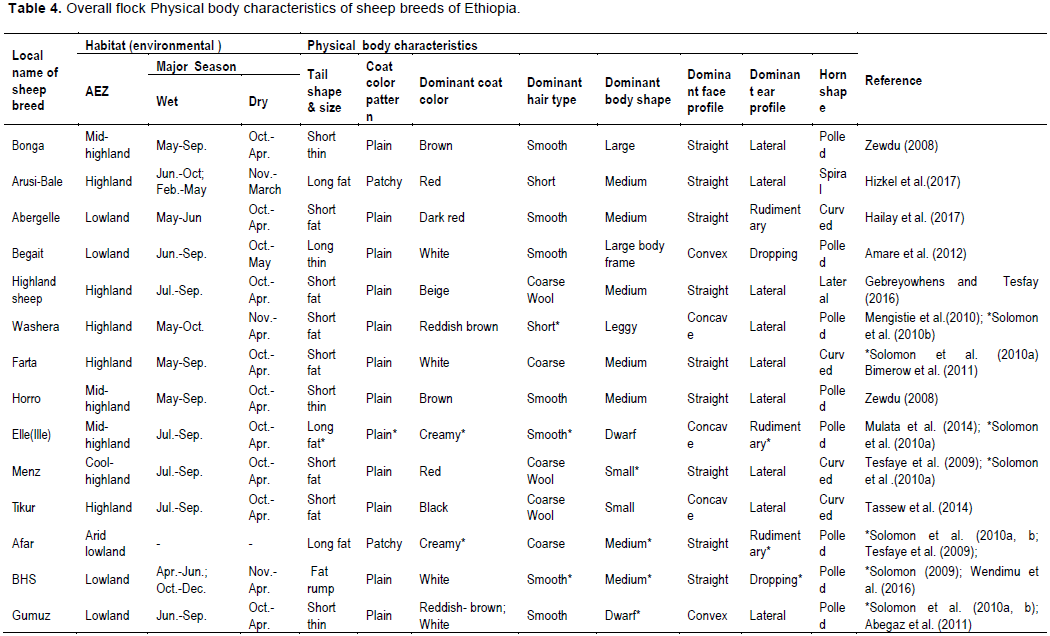
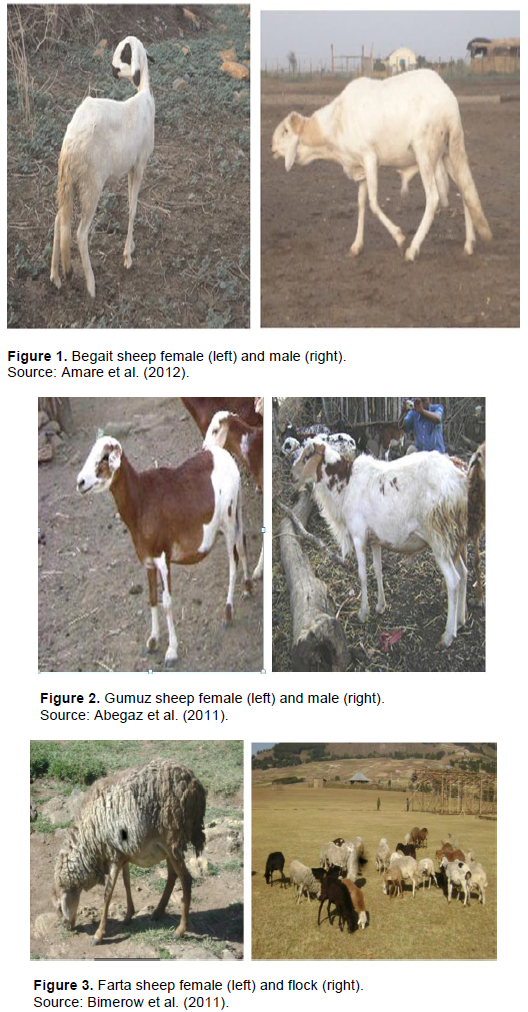
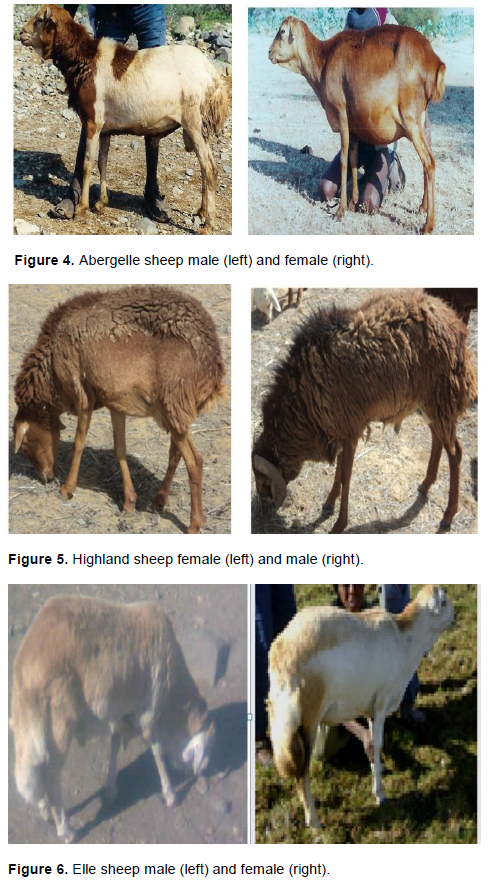
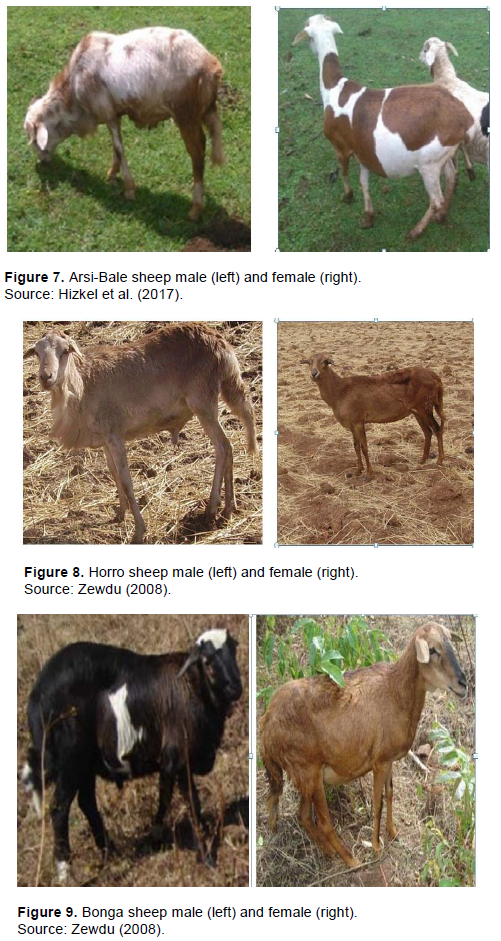

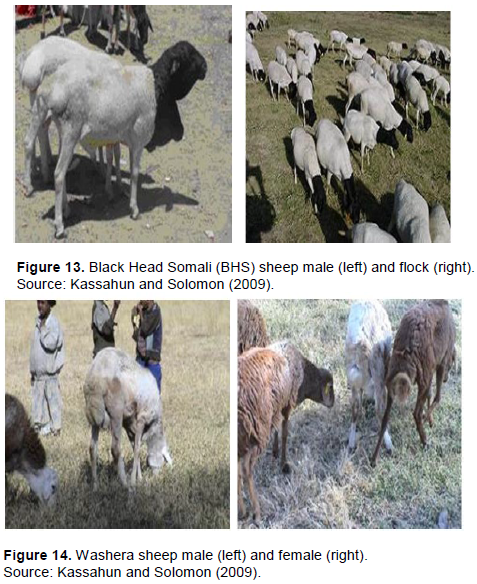
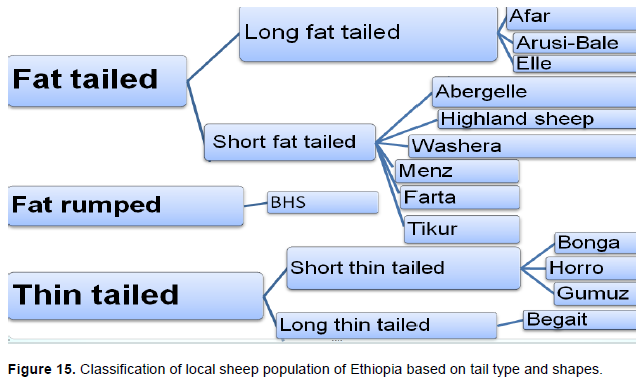
Coat color pattern and hair type description
Using the information collected the dominant descriptors for coat color pattern are listed in Table 4. The local sheep population developed only two major variation of coat color pattern classified into patchy (Afar and Arusi-Bale) and Plain (Elle, Abergelle, Highland sheep, Washera, Menz, Farta, Tikur, BHS sheep, Bonga, Horro and Gumuz and Begait). The dominant observed coat colors are brown coat color (Horro and Bonga), reddish brown coat color (Gumuz and Washera), white coat color (Farta, BHS sheep, Gumuz and Begait), red coat color (Arusi-Bale, Abergelle and Menz), Creamy coat color (Afar and Elle), Beige or pale brown (Highland sheep) and Black coat color (Tikur). Coat color pattern in the indigenous sheep of Ethiopia is not as well evolved as the tail type and shape. The hair type variation is also reviewed as smooth hair type (Elle, Begait, Horro, Bonga, Gumuz, BHS sheep and Abergelle), coarse wool hair type (Tikur, Menz, Farta, Afar and Highland sheep) and short hair type (Arusi-Bale and Washera).
Body shape and face profile description
Using the information collected in Table 4, the indigenous sheep are classified into dominant body profile classification of small (Tikur and Menz); large (Bonga, Begait and Washera), medium (Highland sheep, Arusi-Bale, Abergelle, BHS sheep, Horro, Afar and Farta) and Dwarf (Gumuz and Elle). The face profile of the indigenous sheep are grouped into concave (Elle, Tikur and Washera), straight (Highland sheep, Arusi-Bale, Abergelle, BHS sheep, Horro, Afar and Farta, Horro and Menz) and convex (Gumuz and Begait). The current paper is different from the previous reviewed papers for indigenous sheep of Ethiopia by incorporating Begait sheep which is uniquely identified with convex dominant facial profile and leggy (largest) body conformation (Amare et al., 2012).
Horn and ear profiles description
Based on the dominant horn profile information collected from different source (Table 4), the indigenous sheep are classified into curved (Farta, Abergelle, Menz and Tikur), polled (Begait, Elle, Washera, BHS sheep, Horro, Bonga, Afar and Gumuz); Spiral (Arusi-Bale) and lateral (Highland sheep). The most dominant observed ear profiles (Table 4) of the indigenous sheep are lateral (Farta, Abergelle, Tikur, Horro, Menz, Highland sheep, Arusi-Bale, Gumuz and Washera), dropping (Begait and BHS sheep) and rudimentary (Elle, Abergelle and Afar).
LIVE BODY WEIGHT AND LINEAR MEASUREMENT DESCRIPTION AND CLASSIFICATION
Information on body weight and linear measurement for adult male and female sheep are collected from different published sources as shown in Table 5. Based on the adult (≥2 years) average live body weight, male of the local sheep can be classified into the ranges of 20 to 25 kg (Elle, Abergelle and Menz), 26-30 kg (Highland sheep, Afar and Tikur), 31-35 kg (Bonga, Washera, BHS, Begait and Farta) and 36-40 kg (Arusi-Bale and Gumuz). Similarly, based on the adult average live body, female of the local sheep can be classified into 20-25 kg (Elle, Abergell, Afar, Tikur, Highland sheep and Menz); 26-30 kg (Elle,Tikur, Horro, Washera, BHS, Arusi-Bale and Farta) and 31-35 kg (Gumuz, Begait and Bonga). The overall reviews of the adult average live body weight variation of the local sheep population of Ethiopia are classified into 20-25 kg (Elle, Abergelle and Menz); 26-30 kg (Afar, Tikur, Highland sheep, Washera and BHS); 31-35 kg (Bonga, Begait, Horro, Arusi-Bale and Farta) and 36-40 kg (Gumuz). Mengesha and Tsega (2012) similarly discussed about live body weight rang at the adult age reported as minimum and maximum with 21.5-41.5 kg, respectively for Ethiopian local sheep.
According to the available information in Table 5, HG measurement in the local sheep of Ethiopia varied on average from 57.3 to 82.3 cm and 66.6 to 77.3 cm in male and female, respectively. HW varied on average from 56.4 to 70.2 cm and 58.9 to 71.3 cm for male and female, respectively. BL varied on average from 47.9 to 72 cm and 47.9 to 71.4 cm in male and female, respectively. The current paper reviewed that there is variation on the morphological characteristics among the indigenous sheep breeds of Ethiopia. Solomon (2008) reported that the indigenous sheep population of Ethiopia developed a variation on morphological characteristic and the variation may be due to the effect of ecology, ethnicity, flock management and the overall production system to which they adapted. It is more emphasized that the tail size varied from 12.6 to 50 cm and 6.9 to 38.7 cm in male and female, respectively. There is a special emphasis for using the tail size and shape to classification of the local sheep of Ethiopia into families and sub families (Mengesha and Tsega, 2012; Solomon, 2009; Tibbo, 2006).

The diversified agro ecology of Ethiopia has served as a home for ecologically distinctive sheep population that evolved into sheep breeds. Updating breed characterization research works as national strategy for monitoring the status of sheep population structure and size is not yet well developed as a tool for generating breed based comprehensive information compilation and organization. Separated result of breed characterization information contributes less information about reproductive, productive and genetic relationship information on the existing sheep populations. Representative and systematically collected viable information on the reproductive and production potential for the potential breeds (Begaite) should be done. Comprehensive characterization on morphological description is an essential component of breed characterization for describing, identifying and classification into broad categorization of sheep breeds. There is a variation on the phenotypic performance and appearance among the indigenous sheep population of Ethiopia and showing a potential for designing sustainable breed improvement strategies. Molecular characterization should be done for comprehensive genetic characterization evaluation and classification of the indigenous sheep population at national as the previous result of sheep resource genetic diversity study is not incorporating regionally recognized distinctive sheep breeds (like Begait, Elle, Abergelle and Highland sheep). Breed improvement strategies should be coincided with the adaptive behavior of the indigenous sheep population which is an ongoing process. Participatory research for conducting community based sheep breed improvement should be done through linking village breeding scheme with nucleus breeding programs. Generally, it can be concluded that breeding strategies of the local sheep in Ethiopia should be designed under the consideration of incorporating the production objectives and trait preferences of the society and to maintain the present diversified phenotypic appearances of local sheep for future genetic potential improvement. There are relatively large body size indigenous sheep breed in Ethiopia which can be used to improve other sheep breed in Ethiopia.
The author has not declared any conflict of interests.
REFERENCES
|
Abegaz S, Hegde BP, Taye M (2011). Growth and Physical Body Characteristics of Gumuz Sheep under Traditional Management Systems in Amhara Regional State, Ethiopia. Livestock Research for Rural Development 23(5):11.
|
|
|
|
Amare B, Kefyalew A, Zeleke M (2012). Typical features, characterization and breeding objectives of Begait sheep in Ethiopia. Animal Genetic Resources 51:117-123.
Crossref
|
|
|
|
|
Assen E, Aklilu H (2012). Sheep and goat production and utilization in different agro-ecological zones in Tigray, Ethiopia. Livestock Research for Rural Development 24(1).
|
|
|
|
|
Berhe G (2010). Animal and Plant Health. Directorate-Ministry of Agriculture and Rural Development of Ethiopia. Presented on: Dialogue on Livestock, Food security and Sustainability A side event on the occasion of the 22nd Session of COAG, FAO, Rome on 16:110-116.
|
|
|
|
|
Bimerow T, Yitayew A, Taye M, Mekuriaw S (2011). Morphological Characteristics of Farta sheep in Amhara region, Ethiopia. On line Journal of Animal and Feed Research 1(6):299-305.
|
|
|
|
|
Blench R, Donald KCM (1999). The Origins and Development of African Livestock. Available at :https://www.amazon.com/Origins-Development-African-Livestock.
|
|
|
|
|
Central Statistical Agency (CSA) (2017). Agricultural Sample Survey. Report on Livestock and livestock characteristics (Private peasant holdings). Statistical Bulletin 585(2).
|
|
|
|
|
Gebregiorgis A, Guesh NH, Kidane W, Berihu G (2016). Reproductive Performance of Begait Sheep under different management Systems in Western Zone of Tigray. Journal of the Dairy, Veterinary and Animal Research 3(3):1-5.
Crossref
|
|
|
|
|
Gebreyowhens W, Tesfay Y (2016). Morphological characterization of indigenous highland sheep population of Tigray, Northern Ethiopia. Journal of Natural Sciences Research 6(1):96-104.
|
|
|
|
|
Gavojdian D, Cziszter LT, Sauer M (2013). Productive and reproductive performance of Dorper and its crossbreds under a Romanian semi intensive management system. South African Journal of Animal Science 43(2):219-228.
Crossref
|
|
|
|
|
Gemeda DJ (2010). Participatory definition of breeding objectives and implementation of community ¬based sheep breeding programs in Ethiopia. Doctoral Dissertation.
|
|
|
|
|
Gifford DG, Hanotte O (2011). Domesticating Animals in Africa: Implications of Genetic and Archaeological Findings. Journal of World Prehist 24:1-23.
Crossref
|
|
|
|
|
Gizaw S, Getachew T, Edea Z, Mirkena T, Duguma G, Tibbo M, Rischkowsky B, Mwai O, Dessie T, Wurzinger M, Solkner J, Haile A (2013). Characterization of indigenous breeding strategies of the sheep farming communities of Ethiopia: A basis for designing community-based breeding programs.
|
|
|
|
|
Hailay HT, Banerjee AK, Mummed YY (2017). Morphological characterization of indigenous sheep population in their production system for developing suitable selection criteria in central zone of Tigray, Northern Ethiopia. International Journal of Livestock Production 8(4):40-47.
Crossref
|
|
|
|
|
Hanotte O, Jianlin H (2005). Genetic characterization of livestock populations and its use in conservation decision-making. The role of biotechnology in Exploring and Protecting Agricultural Genetic Resources. Food and Agriculture Organization of the United Nations, Rome pp. 89-96.
|
|
|
|
|
Helen N, Yoseph M, Solomon A, Kefelegn K, Sanjoy KP (2015). Indigenous Sheep Production System in Eastern Ethiopia: Implications for Genetic Improvement and Sustainable Use. American Scientific Research Journal for Engineering, Technology, and Sciences 11(1):136-152.
|
|
|
|
|
Hizkel K, Yoseph M, Yosef T (2017). On Farm Phenotypic Characterization of Indigenous Sheep Type in Bensa District, Southern Ethiopia. Journal of Biology, Agriculture and Healthcare. 7(19):2224-3208.
|
|
|
|
|
Kassahun A, Solomon A (2009). Breeds of Sheep and Goats. Origin, Domestication and Distribution of Sheep and Goats. Ethiopian Sheep and Goat Productivity improvement Program (ESGPIP).
|
|
|
|
|
Mengesha M, Tsega W (2012). Indigenous Sheep Production in Ethiopia: A Review. Iranian Journal of Applied Animal Science 2(4):311-318.
|
|
|
|
|
Mengistie T, Girma A, Solomon G, Sisay L, Abebe M, Markos T (2010). Traditional management systems and linear body measurements of Washera sheep in the western highlands of the Amhara National Regional State, Ethiopia. Livestock Research for Rural Development. 22(9).
|
|
|
|
|
Michael A, Kebede K (2013). Phenotypic characterization of indigenous sheep types and their production systems in east gojam zone of Amhara regional state, Ethiopia.
|
|
|
|
|
Michaele Y, Ashenafi M, Berihan T, Gebreyohannes B (2017). Effect of Feeding Cotton Seed Cake, Dried Acacia saligna, Sesbania sesban or Vigna Unguiculata on Growth and Carcass Parameters of Begait Sheep in North Ethiopia. Agriculture, Forestry and Fisheries 6(5):149-154.
Crossref
|
|
|
|
|
Mulata H, Solomon A, Yoseph M (2014). Within Breed Phenotypic Diversity of Sokota/Tigray Sheep in Three Selected Zones of Tigray, Northern Ethiopia. Journal of Biology, Agriculture and Healthcare 4(17):148-157.
|
|
|
|
|
Oldenbroek K, van der Waaij L (2014). Centre for Genetic Resources and Animal Breeding and Genomics Group, Wageningen University and Research Centre, The Netherlands.
|
|
|
|
|
Seare T, Gangwar S K, Kefelegn K (2011). Performance and physical body measurement of Abergell sheep breed in traditional management system of Tigray regional state, northern Ethiopia. International Journal of science and Nature 2(2):225-230.
|
|
|
|
|
Solomon A, Kassahun A (2009). Estimation of weight and age of sheep and goat. (Eds): Alemu Y, Gipson TA and Merkel RC. Technical bulletin No.23 Ethiopia Sheep and Goat Productivity Improvement Program (ESGPIP).
|
|
|
|
|
Solomon AG, Hegde BP (2007). In-situ characterization of Gumuz sheep under farmers management in north-western lowlands of Amhara region (Doctoral dissertation Haramaya University).pp 75-87.
|
|
|
|
|
Solomon GG (2008). Sheep Resources of Ethiopia Genetic diversity and breeding strategy. PhD thesis,Wageningen University, Available@:
View
|
|
|
|
|
Solomon G (2009). Sheep breeds of Ethiopia: A guide for identification and utilization. Technical bulletin No.28. Alemu Y, Kassahun A, Gipson TA, Merkel RC (eds.). Sheep and Goat Productivity Improvement Program (ESGPIP).
|
|
|
|
|
Solomon G, Azage T, Berhanu G, Dirk H (2010a). Sheep and goat production and marketing systems in Ethiopia: Characteristics and strategies for improvement. Available @:
View
|
|
|
|
|
Solomon G, Aynalem H, Tadelle D (2010b). Breeding objectives and breeding plans for Washera sheep under subsistence and market-oriented production systems. Ethiopian Journal of Animal Production 10(1):1-18.
|
|
|
|
|
Solomon G, Komen H, Hanote O, Arendonk JAM, van Kemp S, Haile A, Okeyo AM, Dessie T (2011). Characterization and conservation of indigenous sheep genetic resources: A practical framework for developing countries. ILRI Research Report No. 27. Available
View
|
|
|
|
|
Tassew M, Kefelegn K, Yoseph M, Bosenu A (2014). On-Farm Phenotypic Characterization of Native Sheep Types in North Wollo Zone, Northern Ethiopia. International Journal of Genetics 4(2):16-25.
|
|
|
|
|
Tesfaye G, Aynalem H, MarkosT, Sharmad AK, Ashebir K, Endashaw T, Wurzingere Mf, Sölkner J E(2009). Morphological characters and body weight of Menz and Afar sheep within their production system. Ethiopian Journal of Animal Production 9(1):99
|
|
|
|
|
Tibbo M (2006). Productivity and health of indigenous sheep breeds and crossbreds in the central Ethiopian highlands. PhD dissertation. Swedish University of Agricultural Sciences (SLU).
|
|
|
|
|
Tsedeke K (2007). Production and marketing of sheep and goats in Alaba, SNNPR. MSc thesis, Hawass University. Hawassa, Ethiopia.
|
|
|
|
|
Urge M, Animut G, Abraham H (2016). Evaluating Production Performance of Tigray Highland Sheep Supplemented with Air Dried Foliages of African Wild Olive and Red Thorn: A Case Study of Carcass Production. Journal of Fisheries and Livestocks Production 4:149-154.
Crossref
|
|
|
|
|
Weldeyesus G, Zelealem T, Yaynishet T (2016). Management and Breeding Objectives of Indigenous Smallholder Highland Sheep in Northern Ethiopia. Journal of Biology, Agriculture and Healthcare. 6(1) Available @
View
|
|
|
|
|
Wendimu B, Wendimu B, Kefelegn K, Yoseph M, Shibabaw B (2016). Phenotypic Characterization of Black Head Somali Sheep in Gode and Adadile Districts, Ethiopia. Global Veterinaria 17(3):265-270.
|
|
|
|
|
Zelealem TG, Anal AK, Gebrezgiher G (2012). Assessment of the sheep production system of northern Ethiopia in relation to sustainable productivity and Sheep meat quality. International Journal of Advaced Biological Research 2(2):302-313.
|
|
|
|
|
Zewdu E (2008). Characterization of Bonga and Horro indigenous sheep breeds of smallholders for designing community based breeding strategies in Ethiopia Directiral dissertation Haramaya University).
|
|